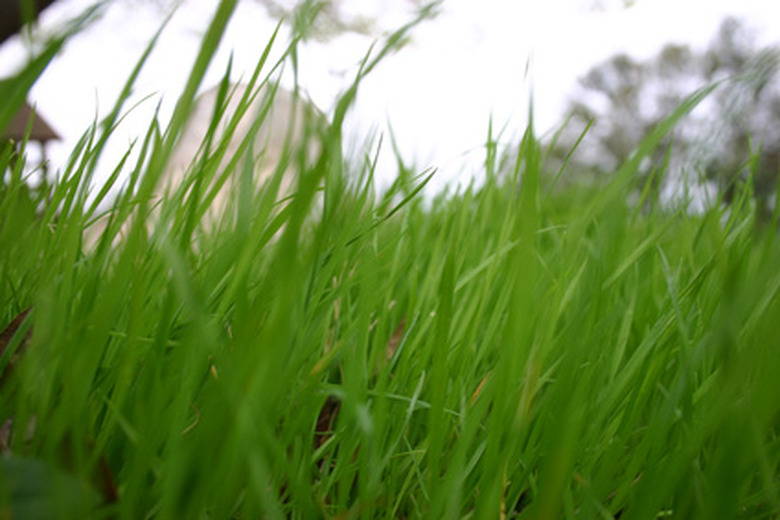How To Improve A Clay Soil Lawn
Things Needed
-
Soil test kit
-
Garden gloves
-
Safety goggles
-
Lawn aerator
-
Aerator boots
-
Shovel
-
Sand
-
Loam
-
Peat
-
Rototiller
-
Shovel
-
Garden rake
-
Lawn mower
-
Grass Seed
-
Lawn fertilizer
-
Liquid clay soil conditioner
Tip
Beware of power lines and cable running through the yard. Call local utility companies a week or so before you dig or till.
Always read and follow directions on fertilizers and soil supplements.
Warning
Don't work with clay soil when soaking wet or you'll end up with a yard full of clods.
Clay soil is heavy and compacts when wet, reducing the amount of oxygen and nutrients available to plants. The result is a sparse lawn with poor drainage. But, with a little know-how, you can improve the soil's condition and in time, grow a thick, green, and healthy lawn. Let's go to work.
Step 1
Test the soil. A soil test determines the fertility of the soil by measuring the amount of nitrogen, phosphorus, potassium and other nutrients that are in the soil. Buy a soil test kit at a garden center or home improvement store, or take a soil sample to your county's extension office, where they will analyze the soil for you. Study the results and amend the soil accordingly.
Step 2
Aerate the soil. Clay soil needs regular aeration to allow water and oxygen to move freely through it. Aerators remove plugs of dirt from the lawn and break up the soil, allowing grass roots to spread. Aerate after the ground thaws, when soil is moist (not soaking) and during the growing season. Aerate cool season grasses in early spring or fall and warm season grasses in late spring or early summer. Aerate compacted soil twice a year. Rent aerators from home improvement stores or equipment companies. Try a pair of aerating spiked boots for small areas.
Step 3
Top-dress the lawn. A more aggressive approach to improving clay soil is to top-dress it. Top-dressing usually consists of sand, loam and peat and spread in various ratios, depending on soil type and location. As a rule, use four parts sand, two parts loam and one part peat. Buy in bags or have a truckload delivered and thinly spread over the existing lawn, making sure the mixture penetrates the soil and allows the existing grass to stick up through the mixture. Add thicker layers to smooth out dip, holes and bumps. Top-dress in September, ideally after aeration. Overseed or plant grass seed in bare areas, if necessary.
Step 4
Till the soil. A highly neglected lawn may need a total lawn overhaul. Rent a rear-tine, self-propelled rototiller to break through the ground surface and till down six inches or so, or where the clay level ends. For isolated problem spots, break up clay with a shovel or heavy garden rake. Till or rake in four parts sand, two parts loam and one part peat.
Step 5
Install a drainage system. Clay soil drains slowly and saturates easily, especially during periods of heavy rain or snow. A lawn drainage system transfers water from one area, through pipes or tiles, to another area, such as a waterway, ditch or man-made bed.
Step 6
Overseed in the fall. Grass ages and eventually dies off, leaving the lawn susceptible to disease, weed and insect infestation. Mow the lawn on the lowest setting and rake the area thoroughly. This allows seed to fall closer to the soil, giving it a better chance to take hold. Spread seed with a hand or push spreader. Water, then cover with straw to keep snacking birds at bay. Seed again in early to mid-spring.
Step 7
Feed the grass. Compacted clay soil prohibits nutrients from reaching grass roots, therefore, prodding roots upward toward the surface. Complete fertilizers contain nitrogen (N), phosphorus (P) and potassium (K) in various ratios, the rate determined by grass type, soil needs, sun-shade requirements and time of year. Lawn fertilizer contains more nitrogen than flower and vegetable fertilizers due to its greening abilities, so look for a fertilizer that has a larger first number, such as 10-2-6. Home improvement stores, discount stores and garden centers sell bags from spring to fall with ratios that work well for the local area. Refer to your soil test report for a more specific treatment. Fertilize at least twice a year when the grass is actively growing: spring and early fall for cool season grasses and late spring through late summer for warm season grasses.
Step 8
Stay off the lawn. Clay soil eventually compacts, especially in areas with heavy foot traffic. Avoid rough play and excessive mowing, particularly when the ground is wet. Lay stepping-stones, install sidewalks or create a path near all entrances and to outbuildings and children's play areas. Designate seating and play areas with mulch, decking or concrete.
Step 9
Mulch the lawn regularly. Take the bag off the lawnmower and leave grass and leaf clippings on the grass. The mulch decomposes and provides nutrients to the soil, while at the same time, inviting in the lawn friendly earthworm. Earthworms snack on the mulch, fertilizing as they move through the soil.
Just like organic mulch, liquid soil conditioners loosen clay soil, allowing water, air and nutrients to penetrate grass roots. Clay soil conditioners contain gypsum, humic acid and catalytic enzymes, and applied during the growing season. These products are usually more costly and take two to three years of routine applications to work, and do not take the place of organic mulching.
Step 10
Water infrequently and deeply. Shallow grass roots are a common problem in clay soils and light, shallow watering causes roots to reach upward, further aggravating the problem. Put the sprinkler on a timer and give the lawn one inch of water per week. Use a rain gauge to measure, if necessary.
